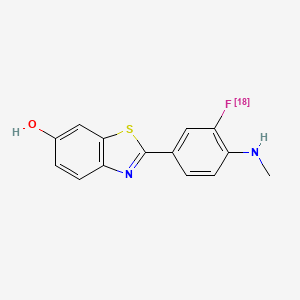



1. (18f)flutemetamol
2. Flutemetamol
3. Vizamyl
1. Flutemetamol F 18
2. Vizamyl
3. Flutemetamol (18f)
4. 18f-flutemetamol
5. Flutemetamol F18
6. Flutemetamol ((sup18)f)
7. 765922-62-1
8. [18f]flutemetamol
9. Flutemetamol F 18 [usan]
10. Flutemetamol (18f) [inn]
11. Chebi:76611
12. L49m066s0o
13. (18f)flutemetamol
14. (18f)ah110690
15. 2-(3-(sup 18)f)fluoro-4-(methylamino)phenyl)-1,3-benzothiazol-6-ol
16. Flutemetamol F 18 (usan)
17. 2-[3-(18f)fluoro-4-(methylamino)phenyl]-1,3-benzothiazol-6-ol
18. 2-[3-(18f)fluoranyl-4-(methylamino)phenyl]-1,3-benzothiazol-6-ol
19. [18f]ah110690
20. Flutemetamol ((sup 18)f)
21. Unii-l49m066s0o
22. Vizamyl (tn)
23. [18f]-flutemetamol
24. Flutemetamol ((18)f)
25. [18f]-flutemetamol F18
26. Gtpl7342
27. Chembl2042122
28. Schembl10032147
29. (18f)flutemetamol [mi]
30. Dtxsid80227394
31. ((18 Sup)f)ah110690
32. Db09151
33. Flutemetamol (18f) [who-dd]
34. Flutemetamol F-18 [orange Book]
35. Ah-110690 F-18
36. D10231
37. Q18355673
38. 2-[3-((18)f)fluoro-4-(methylamino)phenyl]-1,3-benzothiazol-6-ol
39. 2-(3-((18 Sup)f)fluoro-4-(methylamino)phenyl)-1,3-benzothiazol-6-ol
40. 6-benzothiazolol, 2-(3-(fluoro-(sup 18)f)-4-(methylamino)phenyl)-
| Molecular Weight | 273.32 g/mol |
|---|---|
| Molecular Formula | C14H11FN2OS |
| XLogP3 | 3.8 |
| Hydrogen Bond Donor Count | 2 |
| Hydrogen Bond Acceptor Count | 5 |
| Rotatable Bond Count | 2 |
| Exact Mass | 273.060146 g/mol |
| Monoisotopic Mass | 273.060146 g/mol |
| Topological Polar Surface Area | 73.4 Ų |
| Heavy Atom Count | 19 |
| Formal Charge | 0 |
| Complexity | 320 |
| Isotope Atom Count | 1 |
| Defined Atom Stereocenter Count | 0 |
| Undefined Atom Stereocenter Count | 0 |
| Defined Bond Stereocenter Count | 0 |
| Undefined Bond Stereocenter Count | 0 |
| Covalently Bonded Unit Count | 1 |
| 1 of 2 | |
|---|---|
| Drug Name | Vizamyl |
| PubMed Health | Flutemetamol F 18 (Injection) |
| Drug Classes | Diagnostic Agent |
| Drug Label | Vizamyl contains flutemetamol F 18, a molecular imaging agent that binds to -amyloid aggregates, and is intended for use with PET imaging of the brain. Chemically, flutemetamol F 18, is described as 2-[3-[18F]fluoro-4-(methylamino) phenyl]-6-benzot... |
| Active Ingredient | Flutemetamol f-18 |
| Dosage Form | Injectable |
| Route | Intravenous |
| Strength | 40.5mci/10ml (4.05mci/ml); 121.5mci/30ml (4.05mci/ml) |
| Market Status | Prescription |
| Company | Ge Healthcare |
| 2 of 2 | |
|---|---|
| Drug Name | Vizamyl |
| PubMed Health | Flutemetamol F 18 (Injection) |
| Drug Classes | Diagnostic Agent |
| Drug Label | Vizamyl contains flutemetamol F 18, a molecular imaging agent that binds to -amyloid aggregates, and is intended for use with PET imaging of the brain. Chemically, flutemetamol F 18, is described as 2-[3-[18F]fluoro-4-(methylamino) phenyl]-6-benzot... |
| Active Ingredient | Flutemetamol f-18 |
| Dosage Form | Injectable |
| Route | Intravenous |
| Strength | 40.5mci/10ml (4.05mci/ml); 121.5mci/30ml (4.05mci/ml) |
| Market Status | Prescription |
| Company | Ge Healthcare |
Flutemetamol F18 is indicated for Positron Emission Tomography (PET) imaging of the brain to estimate amyloid neuritic plaque density in adult patients with cognitive impairment who are being evaluated for Alzheimer's disease (AD) or other causes of cognitive decline.
FDA Label
This medicinal product is for diagnostic use only.
Vizamyl is a radiopharmaceutical medicinal product indicated for Positron Emission Tomography (PET) imaging of amyloid neuritic plaque density in the brains of adult patients with cognitive impairment who are being evaluated for Alzheimers disease (AD) and other causes of cognitive impairment. Vizamyl should be used in conjunction with a clinical evaluation.
A negative scan indicates sparse or no plaques, which is not consistent with a diagnosis of AD.
Following intravenous injection, flutemetamol F 18 diffuses across the human blood-brain barrier and produces a radioactivity signal detectable throughout the brain. Subsequently, cerebral perfusion decreases the brain flutemetamol F 18 content, with differential retention of the drug in cortical areas that contain -amyloid aggregates compared to areas that lack the aggregates.
Contrast Media
Substances used to allow enhanced visualization of tissues. (See all compounds classified as Contrast Media.)
Radiopharmaceuticals
Compounds that are used in medicine as sources of radiation for radiotherapy and for diagnostic purposes. They have numerous uses in research and industry. (Martindale, The Extra Pharmacopoeia, 30th ed, p1161) (See all compounds classified as Radiopharmaceuticals.)
V09AX04
V09AX04
S76 | LUXPHARMA | Pharmaceuticals Marketed in Luxembourg | Pharmaceuticals marketed in Luxembourg, as published by d'Gesondheetskeess (CNS, la caisse nationale de sante, www.cns.lu), mapped by name to structures using CompTox by R. Singh et al. (in prep.). List downloaded from https://cns.public.lu/en/legislations/textes-coordonnes/liste-med-comm.html. Dataset DOI:10.5281/zenodo.4587355
V - Various
V09 - Diagnostic radiopharmaceuticals
V09A - Central nervous system
V09AX - Other central nervous system diagnostic radiopharmaceuticals
V09AX04 - Flutemetamol (18F)
Absorption
The time-activity curves for flutemetamol F 18 in the brain of subjects with positive scans shows continual signal increases from time zero through 30 minutes post administration, with stable values thereafter up to at least 120 minutes post-injection. Following intravenous injection of 185 MBq (5 mCi) of Vizamyl in humans, flutemetamol F 18 plasma concentrations declined by approximately 75% in the first 20 minutes post-injection, and by approximately 90% in the first 180 minutes.
Route of Elimination
Excretion was found to be approximately 37% renal and 52% hepatobiliary.
The F 18 in circulation during the 30-120 minutes imaging window in plasma was principally associated with flutemetamol metabolites.
Fluorine-18 (F 18) is a cyclotron-produced radionuclide that decays by positron emission (+ decay, 96.7%) and orbital electron capture (3.3%) to stable oxygen-18 with a physical half-life of 109.8 minutes. The positron can undergo annihilation with an electron to produce two gamma rays; the energy of each gamma ray is 511 keV. After flumetamol F18 is given intravenously, it accumulates in beta amyloid plaques in the brain, and thus becomes visible via positron emission tomography (PET).